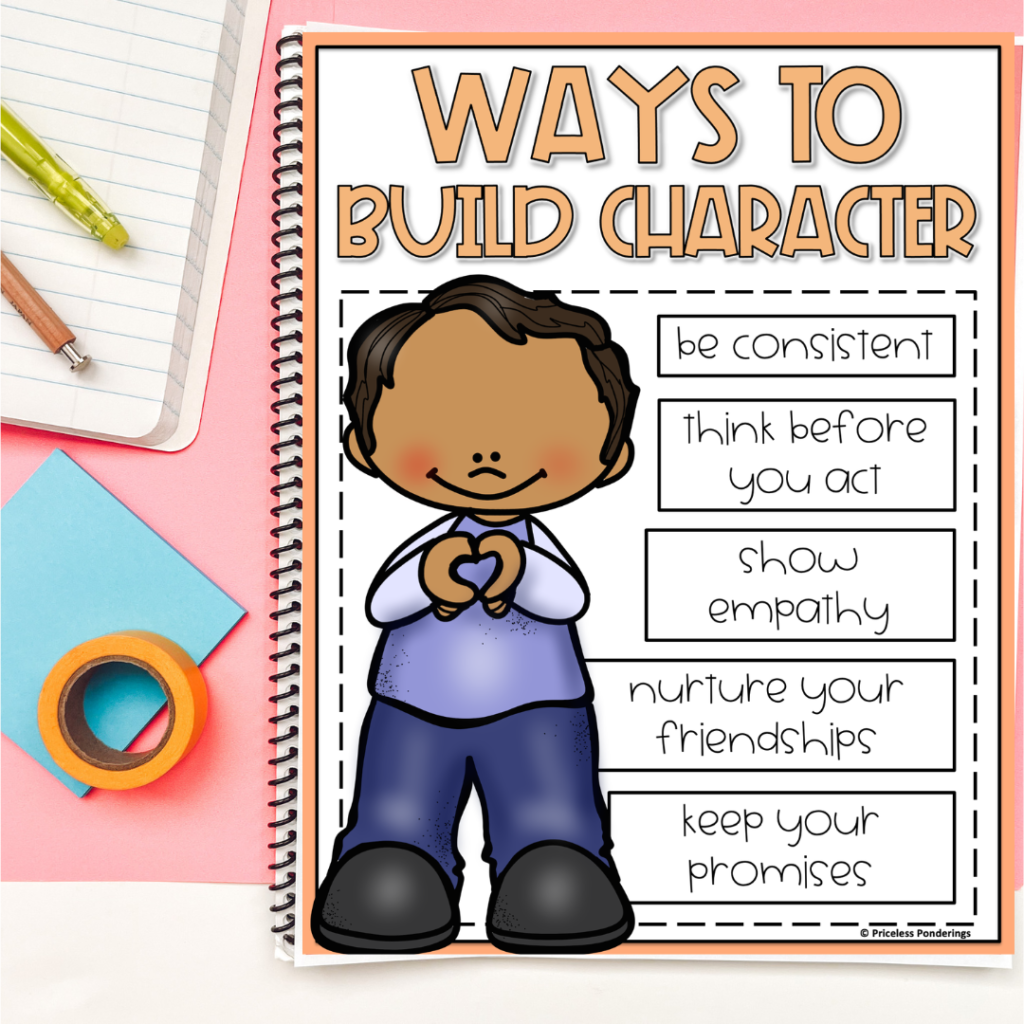How to Teach Positive Character Traits for Kids

In an age where education is not just about academics but also about shaping a well-rounded individual, the focus on character development has become increasingly significant. But how can you, as a homeschool parent or teacher, make character traits more than just another item on a syllabus?
This post offers a hands-on approach to infusing positive traits into everyday learning, ensuring that your students not only understand what a positive character trait is but also embody them.
Whether teaching early elementary students or high school aged kids, learning about positive character traits can have a lasting impact on a child’s development.
Why Character Education Matters
Character education is vital in nurturing positive personal attributes that significantly influence both personal and professional achievements. It focuses on instilling core values such as integrity, responsibility, empathy, and self-discipline, which are essential beyond academic settings and into all life facets.
Students proficient in these positive character traits are equipped to make moral choices, lead in their communities, and foster healthy relationships. Moreover, teaching these virtues in an engaging and fun way enhances students’ tolerance towards individuals displaying negative traits, thereby promoting a harmonious social environment.
Overview of Positive Character Traits
Positive character traits are the building blocks of a well-balanced and successful individual. When looking for ideas or an engaging character traits printable focus on what traits you want your class to learn about. Here is a list of traits you can focus on when teaching character analysis:
- Kindness: Encouraging students to be thoughtful, caring, and considerate of others.
- Perseverance: Teaching the value of persistence and resilience in the face of challenges.
- Responsibility: Instilling an understanding of personal and social duties toward others and the environment.
- Empathy: Cultivating the ability to understand and share the feelings of another.
- Honesty: Fostering a culture of truthfulness and integrity.
- Respect: Promoting the appreciation and regard for oneself and others.
- Cooperation: Highlighting the value of working together and valuing each other’s contributions.

A great way to help students remember these traits is to make an anchor chart. This visual aid can be a super handy reminder and go-to in the classroom. Or, you could go for a colorful character traits list and turn it into a poster. Hanging it up where everyone can see not only brightens up the room but also nudges students to keep looking over and really get those important traits down
Need ideas to help you create anchor charts for your class? Check out this easy to use anchor chart and poster pack here!
Join our Newsletter!

Join our email list to get the latest deals and access to a number of free printable worksheet resources. Each week, I share a new blog post with helpful teaching tips and resources for your class.
We’re all about supporting education, and that means offering free resources to help teachers out. This includes free educational materials that are student-friendly and print-and-go, making sure to save you time and money when lesson planning! Click HERE to join!
Use Easy-To-Follow Lesson Plans

Blending traditional teaching with hands-on activities is a great way to create engaging lesson plans for character education. To save time and ensure thorough coverage of positive traits, I suggest using a pre-made lesson plan. Check out our character traits printable lesson plan unit to jumpstart your character trait curriculum.
This ready-to-use resource organizes a variety of teaching methods into engaging activities that appeal to different learning styles.
Engaging Activities for Teaching Character Traits
So how do we teach character traits in an engaging in fun way!?
To accomplish this, try incorporating a variety of activities specifically designed to teach and reinforce positive character traits. These activities can range from group discussions and role-playing scenarios to creative arts and crafts, each tailored to highlight the importance of values such as honesty, respect, empathy, and responsibility.
By making character education interactive and relatable, you can inspire your students to embody these positive traits in and out of the classroom.
Role-Playing Scenarios

Use role-playing to demonstrate and understand empathy, kindness, and other character traits in various real life situations. Provide students with scenarios that require them to make decisions and act based on a particular trait. Encourage reflection and discussion after each role play to deepen their understanding of character.
Add this fun worksheet to your lesson plans! Download it here!
Classroom/Community Commitment Board
Set up a commitment board in your classroom or homeschool space to lay out responsibilities and agreements. Let each student add to this board, building a community vibe and shared values. It can have tasks, promises, and reminders of the good stuff we all bring to the table.
Go Digital

Use digital resources like a QR code to add a tech-savvy twist to your character education activities. Create a QR code that leads students to inspirational quotes or videos related to the character trait being taught.
Growth Mindset and Perseverance
Guide your students with some fun growth mindset activities to build their perseverance and internal traits. Share favorite books of real people who’ve made it through tough times, or set up a fun game where they need to avoid giving up and having negative character traits. This way, they’ll get that putting in the effort really pays off, boosting their grit and drive to hit their goals.
Discuss Role Models
One of the best way to teach students about a character’s actions is by looking at people they already know. Make a list of real life people or fictional characters who exemplify positive character traits. Have students research and present on these role models, highlighting how their actions display the desired virtues. This approach makes values more tangible and achievable for students.
Literary Characters and Life Lessons
Add in some reading time and use mentor texts. Read and discuss picture books or a short story in which the main characters exhibit positive character traits. Have students discuss how the actions of these specific characters relate to their own lives and experiences, providing them with examples and inspiration to learn and grow. Some popular
You can also incorporate writing activities in a literacy center. Have students create their own social situation where the main character has to demonstrate positive traits when dealing with a new character who may have personality traits that are hard to deal with. This is a great way for students to think outside the box.
Interactive Journals
Another idea is to have kids use an interactive journal. Have students write or draw about their experiences with a character’s trait. Encourage them to give examples of both instances where they displayed a positive trait and when they experienced it from others, promoting self-awareness and appreciation.
Interactive journals also make a great resource for students to jot down ongoing ideas and notes as they learn about different character traits. Have students create graphic organizers like a Venn diagram or a bubble map where they can make a list of their favorite character traits they have learned about.
Character Trait Worksheets

Use printable character traits worksheets and quizzes to assess students’ understanding. These resources can include multiple choice questions, short answer questions, or even matching activities. Have students use text evidence to identify the character’s traits being displayed. This also allows students to list their opinions of the individuals character traits and apply what they have learned to their own value system.
Real-Life Examples
Show how character traits play out in real lie. Share stories, news, or personal experiences about people who’ve really benefited from having strong character traits. This shows how these virtues have a tangible impact and value in the real world.
In character education, it’s crucial to emphasize to children that their internal qualities are what matter most. Stress the importance of how they treat others, underscoring that physical traits such as eye or hair color, physical appearance, and clothing are not what define them.
Tips for Ongoing Encouragement
Fostering positive character traits is not a one-time lesson but a continuous process. Here are a few strategies to ensure that good character is consistently nurtured:
- Model the Behavior You Want to See: Teachers and parents are the most influential role models for students. Your actions and words should align with the character traits you are trying to instill.
- Praise Efforts and Progress: Acknowledge and celebrate instances where students demonstrate positive character traits. This positive reinforcement encourages continuous growth and reinforces the value of the trait.
- Incorporate Traits into Daily Practices: Make character traits a part of your classroom or home culture. Whether through morning meetings, journal reflections, or classroom jobs, find ways to seamlessly integrate character growth into daily life.
- Create a Supportive Environment: Foster an environment where students feel safe to make mistakes and learn. This open setting allows for meaningful conversations and growth opportunities.
How to teach character education to kids
Empowering your students with a strong foundation in positive character traits is an investment in their future. By teaching the strategies outlined in this post, you can create enriching and transformational learning experiences that go beyond the academics into the realm of character development.

Remember, the most effective way to teach character is through actual experiences and active practice; by being intentional and creative in your approach, your students will carry the lessons of character education with them for a lifetime.
Download our character traits printable lesson plan unit to start your character education journey today.
Check Out These Other Popular Posts!
SIMPLIFY YOUR CLASSROOM MANAGEMENT: C.H.A.M.P.S





